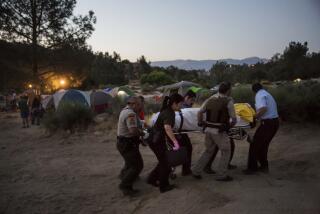Tanks of Life and Breath : Thousand Oaks: A landlocked hospital’s decompression chambers are where divers in trouble are taken for treatment.
- Share via
When Roehl Reyes shot to the ocean surface from a depth of 108 feet, his lungs felt as if they would explode.
That was the last thing Reyes remembered before he blacked out. Dangerous nitrogen bubbles formed throughout his bloodstream, plunging his body deep into shock.
A Coast Guard helicopter rushed his limp body from the waters near Anacapa Island to a decompression chamber at Los Robles Regional Medical Center in Thousand Oaks. After six hours in the pressurized tank, Reyes was in excruciating pain. But he was alive.
“They told me that for 10 minutes I didn’t have a pulse, and I wasn’t breathing,” said the 28-year-old computer programmer from North Hollywood. The chamber “definitely saved my life.”
Los Robles is the only hospital in Ventura County that has a decompression tank. The medical unit has four such tanks, overseen by Dr. Jo L. Wilmeth, an expert in hyperbaric medicine, the science of using decompression in treating patients.
Wilmeth routinely sees scuba divers on the verge of death--an unforeseen hazard that occurs all too frequently on recreational ocean dives.
In Reyes’ case, “he was about to check out on us. It was very frightening,” Wilmeth said. “The tragic part of our service is we see pleasure divers get severely injured.”
In scuba lingo, divers who surface too quickly get “the bends,” a term that describes the effect of the nitrogen bubbles that accumulate in the body due to a rapid change in pressure. Bends can cause paralysis and brain damage, Wilmeth said.
The silver-haired physician himself is an occasional diver. He began working with decompression tanks while in the U.S. Army, serving as a detoxification officer working on curing the effects of chemical warfare.
When Wilmeth first came to Los Robles more than 22 years ago, no other hospital was interested in hyperbaric medicine. At his suggestion, Los Robles in 1974 acquired its first decompression tanks. With those tanks, he could simulate a depth of about 60 feet.
In 1986 Los Robles acquired a larger, more sophisticated decompression chamber that allowed doctors to simulate depths of up to 165 feet below sea level. Los Robles began to treat more injured divers, as one of 47 decompression centers in California.
Until that point, USC’s Catalina Marine Science Center on Santa Catalina Island served as the primary decompression center for divers injured off the Ventura County coast. Although a few patients were taken to Los Robles, it was a rare occurrence.
But a group of divers, including scuba shop owner Steve Madaras of Moorpark, began to complain publicly that Catalina was too far away.
“There were a number of fatalities where the time to get assistance was ridiculous,” Madaras said. In one case, a U.S. Coast Guard helicopter dispatched from Los Angeles took 4 1/2 hours to take a diver to the Catalina chamber. The victim, a diving instructor, died on the way.
Divers mounted a campaign to persuade the Coast Guard to send patients to Los Robles, Madaras said. They won.
“We’ve shaved that time to 25 minutes as a result of having Los Robles hospital nearby,” Madaras said.
Today Los Robles treats injured divers from Ventura to Monterey counties and serves as a backup when the Catalina chamber is busy or unreachable because of the weather. Between 50% and 75% of the divers injured off the Ventura County coastline are treated at Los Robles, Coast Guard officials said. The rest are sent to Catalina.
Los Robles has the advantage of staff physicians available on the premises, said Coast Guard Lt. Harry Allen. “With Catalina, you have to arrange to get a doctor.”
Doctors at Los Robles are on call 24 hours a day and must be ready on 15 minutes’ notice to treat a patient who has been brought in by helicopter.
Authorities say a local decompression chamber is important because of the growing sport of recreational diving off the county’s 42 miles of coastline and the nearby Channel Islands.
The county Diving Safety Committee, an informal group of divers and physicians interested in hyperbaric medicine, estimates that there are 1 million ocean dives a year off Ventura County, Wilmeth said.
“The Channel Islands are one of the major dive sites on the California coastline,” said Sheriff’s Lt. Arvid Wells, who heads the county’s search and rescue teams.
Although the county is fortunate enough to have a decompression center, that has not saved all those involved in diving accidents. During the past two years, Los Robles treated 59 divers, many of them nearly lifeless, Wilmeth said.
Six people died in scuba-diving accidents in 1989 and 1990, according to the county coroner’s office.
Wilmeth predicted an increase in accidents as commercial urchin and abalone crews expose themselves to risks to harvest a catch that is becoming harder to find. “The deeper they go, the more work they do, the more they get the bends,” he said.
So far this year, Los Robles has handled seven cases, all successfully.
The hospital is planning a $500,000 expansion to replace three of its smaller decompression tanks with four larger chambers that can simulate greater depths. There is already one such chamber at Los Robles, a shiny, 12-foot-long tank called a Reneau.
Round, submarine-like windows allow technicians to peek in on patients, while blinking monitors show heart rates, pressure inside the tank and oxygen content. The double lock allows an attendant to enter in case of an emergency without losing pressure.
Wilmeth also uses the tanks to treat many patients suffering from gangrene, skin infections, carbon monoxide poisoning, snake and spider bites. The tanks help these patients by getting oxygen to affected areas. Oxygen under pressure is better absorbed into a patient’s lungs and blood vessels.
Edward Kiner, 52, of Agoura came to Los Robles more than a year ago after battling staph infections in both feet.
At that time Kiner could barely walk, his feet were so infected. Doctors talked about amputation.
For 11 months, Kiner visited the decompression chamber two or three times a week. Nurses pushed him into a clear, cylindrical tank of clear plastic that looks much like a large test tube. For 90 minutes, he would read, listen to music, watch television or nap.
At $300 a visit, the treatment was not cheap. Kiner’s medical bills mounted to more than $75,000, he said. But amputation, artificial limbs and physical therapy would have cost twice as much.
Kiner no longer uses crutches. He walks unaided without a limp.
“As far as I’m concerned, Dr. Wilmeth’s a miracle worker,” Kiner said. “If this had not worked, I could have lost both my feet.”
Not all divers suffering from the bends are rushed to Los Robles under life-threatening conditions. Sometimes, divers say, the symptoms are so slight that they often go unnoticed for days.
When Thousand Oaks diving teacher Tim Coates, 42, jumped into the ocean near San Pedro two years ago, he descended to a depth of more than 200 feet twice to retrieve an anchor.
Coates said he didn’t think he was ill until days later, when one arm felt as if it were being strangled. He checked himself into Los Robles. Several hours inside the tank relieved the pain. It turned out to be a mild case of the bends.
“I had never had to be treated for anything before,” he said. “The chamber seemed to have taken care of it.”
It took Reyes weeks of sessions in the decompression tanks to help his body adjust after his life-threatening ascent in the waters off Anacapa Island.
Reyes could have suffered brain damage and paralysis from the bends, Wilmeth said. As it was, it took him weeks to regain movement in parts of his body.
For two weeks, Reyes went into the decompression tank twice a day. Gradually, the pain in his lungs subsided and his memory returned. He is now back to work at the Bugle Boy company in Simi Valley.
“At this point, I think I’m back to normal,” Reyes said. “The chamber did a good job.”
More to Read
Sign up for Essential California
The most important California stories and recommendations in your inbox every morning.
You may occasionally receive promotional content from the Los Angeles Times.













![Vista, California-Apri 2, 2025-Hours after undergoing dental surgery a 9-year-old girl was found unresponsive in her home, officials are investigating what caused her death. On March 18, Silvanna Moreno was placed under anesthesia for a dental surgery at Dreamtime Dentistry, a dental facility that "strive[s] to be the premier office for sedation dentistry in Vitsa, CA. (Google Maps)](https://ca-times.brightspotcdn.com/dims4/default/07a58b2/2147483647/strip/true/crop/2016x1344+29+0/resize/840x560!/quality/75/?url=https%3A%2F%2Fcalifornia-times-brightspot.s3.amazonaws.com%2F78%2Ffd%2F9bbf9b62489fa209f9c67df2e472%2Fla-me-dreamtime-dentist-01.jpg)